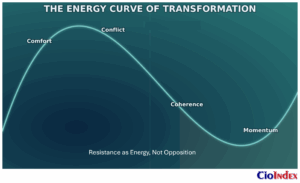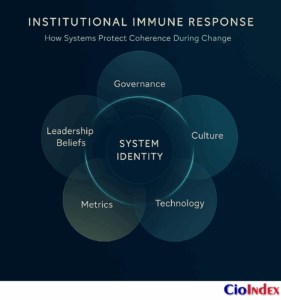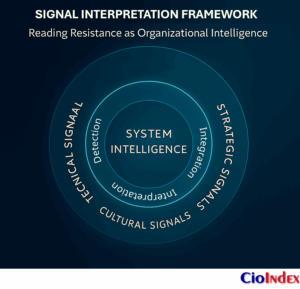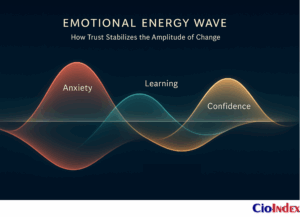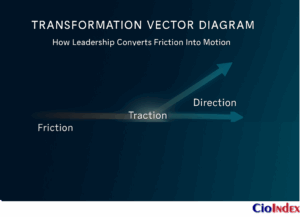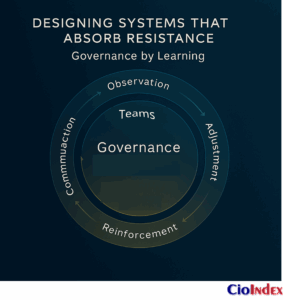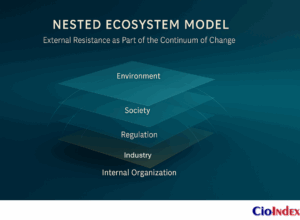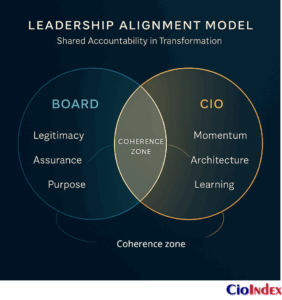The Nature of Resistance
Transformation is often mistaken for motion — the sense of an enterprise advancing toward something new. Yet its true beginning is friction. The instant change begins, the same structures that once sustained performance begin to resist it. What leaders interpret as obstruction is often the system preserving its coherence.
Digital transformation reveals a deeper truth: progress and preservation share the same design. Every process, control, and behavior that made an organization reliable also trained it to defend itself. The discipline that once ensured excellence becomes the reflex that constrains evolution. Resistance is not incompetence; it is memory — the echo of success encoded in structure.
Most transformations fail not from technical limitation but from psychological gravity. The enterprise is a living archive of its own victories. Its habits remember the logic of stability: optimize for certainty, reward predictability, measure success through repetition. When the logic of adaptability demands experimentation and ambiguity, the old system experiences it as disorder. The result is a quiet collision between two forms of intelligence — the intelligence of efficiency and the intelligence of evolution.
The pattern is visible across industries. More than seventy percent of digital initiatives stall or regress, not because systems break, but because conviction weakens. Organizations begin to negotiate with their own ambition, slowing progress to defend identity. Fatigue becomes symptom; self-preservation remains cause.
True transformation requires more than innovation; it requires identity elasticity — the ability to evolve without losing coherence. The enterprise must learn to change its function without erasing its form. This is the discipline of continuity: governance that interprets resistance as reflection, not rebellion — the organization testing whether its future design still resembles its values.
Progress is not acceleration; it is reconciliation — the deliberate balance between what must endure and what must change. The task of leadership is to turn that tension into design.
Transformation begins with technology but fails with psychology. The organizations that endure are those that learn to move without forgetting who they are.
The Anatomy of Resistance — Systems That Protect Themselves
Every organization is designed to endure. Its systems, metrics, and hierarchies exist to sustain continuity under pressure. When transformation begins, that same continuity asserts itself. Resistance is not emotion; it is design in defense of its own logic. It operates through structural, cultural, cognitive, and political layers — a network of self-preserving mechanisms that interpret change as instability. Understanding these layers reveals resistance not as defiance, but as architecture: a system behaving exactly as it was built to.
Structural Inertia — The Architecture of the Past
Each enterprise carries residual logic from the era in which it was optimized. Processes, approval flows, and accountability frameworks evolve around the assumptions of that time — growth through control, success through predictability. When those conditions change, the architecture lags behind its environment.
Structural inertia is not inefficiency; it is efficiency prolonged beyond relevance. The governance structures that once enabled precision now slow adaptation. Decision rights remain bound to obsolete hierarchies, and metrics continue to reward scale over learning. The result is architectural lag — the gap between the design of operations and the rhythm of transformation.
Transformation does not fail because these systems resist; it fails because they succeed too well at preserving their prior purpose. Inertia is the shadow of mastery.
Cultural Immunity — The Unwritten Constitution
If structure preserves design, culture preserves meaning. Every organization builds an informal constitution — the shared language, rituals, and stories that define what belongs. These unwritten norms decide which behaviors are rewarded and which are quietly discouraged.
When digital transformation demands transparency, experimentation, or cross-functional collaboration, these norms interpret it as risk. The culture’s immune system responds: silence replaces challenge, symbolic gestures substitute for change, and compliance masquerades as commitment.
This defense mechanism is not sabotage. It protects identity — the collective agreement about how success is earned. Transformation that ignores these unwritten codes meets resistance that cannot be reasoned with, only reinterpreted. Change becomes credible when it speaks the language of the culture it seeks to evolve.
Cognitive Dissonance — Leadership Under Strain
The most persistent resistance arises in perception. Digital transformation forces leaders to reinterpret what it means to be competent. Expertise built in a previous paradigm becomes less predictive in the next. The instinctive response is defense — to lead by precedent rather than by possibility.
This cognitive drag slows transformation even when strategy is sound. Decisions are filtered through the comfort of past models, and information that contradicts established logic is downplayed. Endorsement remains high, but conviction fades.
Governance can mitigate this dissonance through structure, not persuasion. When decision frameworks make learning visible — through transparent criteria, shared accountability, and explicit experimentation windows — authority and adaptability coexist. Confidence becomes transferable again.
The Politics of Persistence — Power and Incentives
Transformation redistributes power. It changes who defines value, who allocates resources, and who is visible in success. Resistance often hides within these redistributions. Reporting lines, budgets, and performance measures become quiet instruments of continuity — preserving the authority that transformation threatens to disperse.
Incentive systems, too, are slow to evolve. They reward precision when uncertainty demands exploration. They prize ownership when collaboration creates impact. When recognition remains bound to efficiency, innovation becomes reputationally expensive.
Governance must therefore realign authority with intent. Decision rights and resource control should move in tandem with new value creation. Power Reallocation Velocity (PRV) — the time required for decision ownership to match operating reality — becomes a leading indicator of organizational adaptability. Low velocity signals control without confidence; high velocity signals trust converted into motion.
Typology of Resistance — Reading the System’s Defense
Resistance appears in patterns, not anomalies. Recognizing these patterns allows leadership to treat resistance as data rather than disruption.
- Structural Echo — Legacy processes that persist because their removal feels unsafe.
- Active Opposition — Open pushback rooted in identity defense; disruptive but clarifying.
- Strategic Ambiguity — Agreement without execution; alignment performed to preserve control.
- Constructive Friction — Purposeful tension that tests design coherence; resistance as discipline.
Table 1: Common Resistance Mechanisms and Their Organizational Function
| Mechanism | Expression | Function | Productive Counteraction |
|---|---|---|---|
| Risk aversion | Slow decision cycles | Protects stability | Introduce safe-to-fail pilots |
| Legacy systems | Inflexible processes | Preserve continuity | Modular modernization |
| Cultural fatigue | Cynicism toward change | Maintains identity | Connect change to meaning |
Mature enterprises cultivate the last form. They ritualize dissent, making challenge a governance function rather than an act of defiance. Resistance becomes an analytic signal — evidence of where the system’s logic conflicts with its ambition.
Resistance is not the failure of transformation but the feedback of continuity. It is the organization proving the strength of its prior design. When leaders learn to read these signals, resistance becomes a diagnostic map — the first form of system intelligence.
Change begins not when resistance ends, but when its patterns are understood.
Resistance as System Intelligence — Reading the Signals
Organizations speak through their behavior. The pauses, detours, and delays that surface during transformation are not silence; they are language. Resistance is the enterprise articulating where its logic and its direction diverge. When leaders suppress that signal, they erase the system’s capacity to learn. When they listen, they discover that resistance is intelligence — the organization revealing how it interprets change.
Every enterprise generates this intelligence differently. In some, resistance takes the form of procedural friction — bottlenecks and reversions that mark the edges of legacy design. In others, it manifests as hesitation, fatigue, or competing narratives. What matters is not the form but the meaning. Each act of resistance describes the distance between what the enterprise intends and what it can presently sustain. To read that distance is to understand the organization as a living system — one that thinks, reacts, and defends itself in real time.
From Friction to Feedback
Friction is not the opposite of progress; it is its evidence. Every slowdown, delay, or disagreement signals an interface between old logic and new intent. Resistance identifies the seams of transformation — those moments where ambition outpaces alignment.
When leaders treat friction as failure, they silence the feedback loop that makes change intelligent. But when they study it, they begin to see structure in motion. Each conflict or delay becomes a kind of audit — the organization revealing where its design no longer fits its aspiration. Resistance becomes diagnostic: the first feedback system of transformation itself.
Mapping the Friction — The Change Topography
Resistance leaves patterns. It gathers around predictable locations: approvals that take longer than intent allows, workflows that revert to manual control, or meetings where agreement hides uncertainty. These are not random disruptions but coordinates on a map — a Change Topography that traces where transformation meets constraint.
Within this landscape, three dimensions recur:
- Procedural friction — misalignments between decision flow and accountability.
- Behavioral friction — gaps between narrative and incentive.
- Cognitive friction — diverging interpretations of strategy and meaning.
Seen together, these contours describe how deeply transformation has penetrated the system. The denser the friction, the more faithfully the organization is revealing its design to itself. Mapping these interactions converts emotion into evidence — the first step from reaction to intelligence.
Decoding Motives — From Opposition to Insight
Most resistance is not irrational. It follows an internal logic — loyalty to values, preservation of competence, or defense of meaning. Treating all resistance as obstruction blinds leadership to its insight. Every objection conceals a hypothesis about how the system works.
Two motives, in particular, provide the most value.
Principled resistance arises when transformation threatens purpose or ethics. It protects coherence — the enterprise asking whether the change still honors what it stands for.
Procedural resistance surfaces when declared intentions are not structurally supported. It reveals friction in design — a mismatch between rhetoric and mechanism.
Both are essential. The first preserves integrity; the second improves execution. Leaders who learn to separate motive from emotion discover that resistance is often the most reliable governance audit available to them.
Feedback as Capital — Learning Through Reflection
Once resistance is interpreted, it becomes measurable. The same friction that slows progress can quantify adaptability.
Three indicators convert that feedback into capital:
- Resistance Density (RDI) — the proportion of processes displaying persistent friction.
- Alignment Velocity (AV) — the rate at which conflicting priorities converge after adjustment.
- Sensemaking Velocity (SV) — how quickly collective understanding stabilizes once new direction is introduced.
The ratios between them reveal the system’s learning rhythm. High resistance with low sensemaking velocity indicates overload — change without comprehension. Moderate resistance with rapid alignment suggests resilience — a system learning through motion. In this light, friction is no longer an obstacle; it becomes evidence of organizational metabolism.
Cognitive Sensemaking — The Architecture of Understanding
Organizations rarely resist what they understand. They resist what they cannot yet make sense of. When strategy outpaces meaning, anxiety fills the gap. The problem is not disagreement; it is disorientation.
Sensemaking repairs coherence. It aligns narrative, structure, and action so that people can locate themselves inside the transformation. When explanation catches up to intent, resistance subsides — not because uncertainty vanishes, but because confidence returns.
Sensemaking velocity, then, becomes a form of cultural intelligence. It measures how quickly purpose can reassemble itself after disruption. In mature enterprises, this velocity approaches rhythm — an internal cadence through which change becomes continuity.
Resistance is not noise to be silenced but memory to be interpreted. It is the organization thinking out loud, rehearsing its next identity before accepting it. When leadership learns to hear that language, transformation stops being a contest between control and change — it becomes a conversation between what the enterprise was and what it is becoming.
The strength of an organization lies not in how little it resists, but in how wisely it listens to what its resistance is trying to say.
The Emotional Physics of Change — Energy, Fatigue, and Trust
Every transformation runs on energy. Strategy provides direction, technology provides capability, but energy determines duration. Organizations change at the rate their people can sustain belief. When that belief erodes, no amount of planning or investment restores motion.
Change consumes emotional capital faster than financial capital. Each new initiative demands attention, focus, and optimism — scarce resources in systems built for predictability. Over time, the continuous acceleration of transformation creates a different kind of debt: change fatigue, the invisible tax that drains conviction faster than results can replenish it.
Energy, in this sense, behaves like physics. It cannot be created by decree; it must be transferred, balanced, and renewed. Leadership defines not just what must change, but how the emotional economy of change is maintained.
Emotional Energy as Organizational Currency
Energy is the measure of engagement multiplied by meaning. It represents the alignment between what people are asked to do and what they believe it achieves. When that alignment is strong, energy compounds — progress generates enthusiasm. When it weakens, motion persists but momentum fades.
In most transformations, energy loss begins quietly. Meetings still occur, reports still flow, but attention thins. What was once initiative becomes routine. The emotional signal of transformation — curiosity, urgency, purpose — dissipates into procedural noise.
Managing energy, therefore, is not about motivation; it is about coherence. Every decision either deposits or withdraws from the organization’s emotional balance sheet. Energy is preserved when people can see how their effort connects to meaning — when progress feels like participation, not compliance.
Change Fatigue — The Entropy of Transformation
Fatigue is not resistance; it is depletion. It appears when the pace of change exceeds the organization’s capacity to interpret and absorb it. What begins as engagement turns into exhaustion, not because the vision is unclear, but because the system lacks time to metabolize it.
Continuous transformation creates entropy — the natural decay of attention and trust that occurs when adaptation becomes perpetual. The signs are subtle: enthusiasm replaced by compliance, initiative by caution, learning by defense.
Without deliberate recovery cycles, even successful change erodes the will to continue. Momentum without renewal becomes extraction. The organization begins to optimize for survival rather than progress — a quiet inversion that marks the emotional limit of transformation.
Psychological Safety — The Architecture of Renewal
Sustained energy requires safety — not the absence of risk, but the presence of trust. Psychological safety is the environment in which fatigue can be expressed without penalty and doubt can surface without fear. It transforms resistance into conversation and burnout into signal.
In unsafe cultures, resistance hides. People protect themselves through silence, and silence becomes the system’s most dangerous blind spot. In safe ones, dissent circulates early, allowing pressure to release before it becomes fatigue.
Psychological safety is therefore not a cultural artifact; it is a design principle. It is built into meeting structures, communication patterns, and leadership behaviors that make uncertainty discussable. Safety accelerates adaptation because it transforms anxiety into inquiry — the most renewable form of energy an organization possesses.
Trust as Energy Multiplier
Trust amplifies energy by reducing friction. It compresses the distance between intent and interpretation, between what leaders say and what teams believe. Without it, every initiative requires reinforcement; with it, alignment becomes automatic.
Trust cannot be mandated. It accrues through consistency — the repeated alignment of words and consequences. When commitments are honored, information flows freely and resistance evolves into feedback. The system moves as one organism rather than many parts negotiating control.
Trust also restores energy. In periods of transformation fatigue, people draw stability not from certainty but from credibility — the confidence that change is being led with integrity. Trust becomes the invisible infrastructure that allows belief to circulate faster than instruction.
Measuring the Emotional Economy
Like any other form of capital, emotional energy can be observed through its effects. Three signals reveal the state of the organization’s emotional economy:
- Engagement Density (ED) — the proportion of teams displaying sustained discretionary effort across initiatives.
- Sentiment Stability (SS) — the consistency of trust and optimism across communication cycles.
- Recovery Ratio (RR) — the time required for morale to return after a high-intensity change event.
Healthy systems display variability — bursts of effort followed by renewal. Unhealthy ones show constant exertion with no recovery, or prolonged stillness that masks exhaustion. The goal of leadership is not perpetual energy but rhythmic energy — effort and renewal in deliberate sequence.
Renewal as Governance
Governance sustains change not through control but through rhythm. It defines the intervals between acceleration and reflection — the organizational equivalent of breathing. Without these intervals, strategy outpaces capacity and fatigue becomes systemic.
Renewal is not retreat; it is calibration. It allows the enterprise to integrate experience, reconstitute trust, and re-energize its people for the next phase of motion. In mature organizations, renewal is built into governance: retrospectives, recognition cycles, and pauses that convert exhaustion into learning.
The measure of transformation health is therefore not speed but stamina — how coherently an organization can sustain direction over time without eroding belief.
Change consumes energy; renewal restores it. Between the two lies the discipline of trust — the invisible mechanism that converts effort into endurance. The physics of transformation are emotional before they are operational. An organization does not burn out because it changes too fast, but because it forgets to replenish what makes change possible: belief.
Transformation endures when energy becomes governance, and trust becomes its most renewable source.
Leadership and the Physics of Change — Converting Friction into Traction
Leadership is the force that turns potential into direction. In transformation, its work is not to eliminate friction but to shape it. Every enterprise generates tension between continuity and renewal; leadership defines whether that tension produces heat or movement.
When leaders interpret resistance as energy rather than error, transformation gains coherence. Friction becomes traction — the controlled resistance that makes progress measurable. The physics of change are simple: momentum equals intention multiplied by trust, divided by friction. Leadership supplies the variables.
Energy Transfer — Momentum Meets Friction
Change begins as stored energy: vision, urgency, belief. It accelerates only when that energy transfers through structure. Leadership provides the vector of that transfer. Too little force, and inertia prevails; too much, and the system fractures.
Effective leaders modulate acceleration. They convert resistance into leverage — each objection revealing where understanding must deepen, where systems must adjust. Momentum built through listening is stronger than momentum imposed through command. The goal is not speed, but stability under motion.
The Empathy–Authority Paradox
Every transformation demands both firmness and care. Authority creates direction; empathy creates adhesion. Without authority, change drifts. Without empathy, it breaks.
Empathy is not concession; it is calibration. It measures the emotional cost of progress and translates it into design choices: pacing, communication rhythm, visible recognition. Authority, in turn, ensures that empathy does not dissolve into indulgence. Together they form the dual current that keeps transformation aligned with purpose.
The paradox resolves when leaders understand that empathy is a form of control — not over people, but over volatility.
Narrative as Force Field
Strategy defines what changes; narrative explains why. Between them lies belief. When belief weakens, energy disperses.
Leadership sustains momentum by maintaining narrative coherence — a shared storyline that connects individual contribution to collective purpose. The narrative must evolve as transformation unfolds: from urgency (“why we must change”) to identity (“who we are becoming”).
Every communication, every decision, reinforces or fractures this coherence. The organization’s emotional field is shaped less by information than by interpretation. A consistent narrative converts uncertainty into direction — the invisible gravity that holds motion together.
The Temporal Dimension — The Half-Life of Change
Momentum decays without renewal. Enthusiasm, clarity, and focus all have half-lives. Leadership extends them by rhythm — the deliberate alternation between push and pause.
Interventions, milestones, and recognition moments act as energy injections, re-aligning attention with progress. Without them, transformation enters entropy: initiatives continue, but meaning diffuses.
Sustained motion depends on cadence. Leadership that understands time as design — not as urgency — builds endurance. In mature enterprises, timing becomes governance: when to accelerate, when to absorb, when to let belief catch its breath.
Table 2: Leadership Responses to Resistance
| Resistance Type | Common Misinterpretation | Effective Leadership Response |
|---|---|---|
| Technical delay | Inefficiency | Probe for systemic dependency |
| Cultural pushback | Negativity | Translate values, not orders |
| Strategic hesitation | Indecision | Revisit coherence, not compliance |
Translating Friction into Design
Friction is information; leadership turns it into architecture.
When teams hesitate, it signals uncertainty in purpose.
When decisions stall, it reveals gaps in accountability.
When fatigue spreads, it exposes imbalance in rhythm.
The leader’s task is to translate each form of resistance into a design adjustment — clarifying goals, redistributing authority, or restoring capacity. In doing so, leadership converts tension into structure. Friction ceases to be waste; it becomes feedback integrated into the mechanics of progress.
The Momentum Equation
Momentum is not an abstraction; it has structure.
Momentum = Purpose × Participation ÷ Friction
Purpose aligns direction. Participation multiplies force. Friction determines efficiency. Leadership influences all three. When purpose is clear and participation voluntary, friction becomes productive — the controlled resistance that provides traction. When purpose fractures or participation fades, friction turns from stabilizer to constraint.
The art of leadership lies in managing this equation dynamically, ensuring that every interaction either strengthens clarity or reduces unnecessary drag.
Leadership in transformation is an act of conversion — energy into motion, friction into traction, belief into endurance. It succeeds not by removing resistance but by redistributing it across the system so that learning and movement coexist.
Progress depends on how gracefully leadership turns pressure into pattern.
Momentum endures when friction is not fought, but used.
Designing Systems That Absorb Resistance — Governance by Learning
The most advanced organizations do not overcome resistance; they design systems that can absorb it. Transformation that endures is not powered by control but by learning — a continuous conversion of friction into feedback, and feedback into refinement.
Governance, in this context, is not an enforcement mechanism but a learning architecture. It connects purpose, performance, and perception in real time. The enterprise ceases to treat change as disruption and begins to treat it as metabolism — a living system adjusting itself to stay coherent under new conditions.
Resistance becomes not what slows transformation, but what sustains it — the signal that keeps adaptation intelligent.
Participation Architecture — From Compliance to Co-Creation
Most change fails because people execute what they did not help design. Participation is the structural antidote to resistance. When those affected by change become architects of it, alignment replaces compliance.
A participation architecture distributes authorship. It invites cross-functional teams, customers, and partners into design cycles, making transformation a shared act of interpretation. Each layer contributes insight from its proximity to reality, turning governance from hierarchy into network.
In this model, ownership is emotional before it is operational. Co-creation transforms belief into design. The system moves because people see themselves in its motion.
Feedback Infrastructure — Listening in Real Time
Change requires instruments that can hear. Feedback infrastructure translates organizational emotion into data: pulse surveys, sentiment analytics, decision-cycle tracking, and open communication channels that convert reaction into measurable signal.
The sophistication of this infrastructure determines how intelligently resistance is interpreted. In low-maturity systems, feedback is anecdotal — collected and ignored. In mature ones, it becomes an operational feed — a continuous input into governance decisions.
Feedback, once integrated, redefines control. The organization no longer reacts after deviation; it adjusts during movement. Resistance ceases to be a problem to fix and becomes a form of dialogue the system conducts with itself.
Learning Loops — The Mechanics of Adaptation
Every resilient enterprise runs on learning loops — iterative cycles that transform uncertainty into pattern. They begin with observation, continue through experimentation, and close with institutional memory.
Micro-transformations — small, visible experiments — are the practical units of these loops. Each proves or disproves a hypothesis about how the organization behaves under change. Success validates; failure educates. Both outcomes improve precision.
The system evolves not through declarations but through repetition. Each loop strengthens alignment between design and reality, ensuring that progress is verified before it scales. Learning becomes the quality assurance of transformation.
Trust Flow — The Circulation of Credibility
Information alone does not produce adaptation; trust does. For learning loops to function, insight must travel faster than authority. Trust is the medium of that flow — the invisible current that allows feedback to move without distortion.
When employees trust that candor will not be penalized, resistance becomes data. When leadership trusts its teams to act on insight, feedback becomes response. This reciprocal circulation is what differentiates adaptive governance from administrative control.
A simple indicator — Trust Flow Index (TFI) — measures how quickly information converts into decision. Low TFI signals fear; high TFI signals coherence. Trust is the medium through which motion becomes meaning.
Ethical Transformation Fatigue — Renewal as Design
Sustainability in transformation is not environmental; it is human. An organization that accelerates without recovery violates its own social contract. The result is ethical fatigue — exhaustion that feels not just physical, but moral.
Designing for renewal is therefore an ethical act. Governance must create intervals of reflection where progress can be questioned, celebrated, and recalibrated. Recognition, retrospectives, and rest are not indulgences; they are structural requirements for truth.
The Transformation Sustainability Ratio (TSR) — the balance between change speed and recovery capacity — reveals how responsibly an enterprise is evolving. Sustainability is no longer a separate agenda; it is a measure of integrity under motion.
Resistance as Renewable Resource
When feedback, learning, and trust intersect, resistance becomes renewable — a recurring input into organizational intelligence. Each cycle of tension and response refines the design of systems and the judgment of leaders.
This is the essence of adaptive governance: progress not defined by absence of error, but by mastery of response. The more elegantly resistance is absorbed, the more resilient the organization becomes. What was once defended against now provides the friction that sharpens alignment.
The mature enterprise does not fight resistance; it metabolizes it.
Every act of dissent becomes a contribution to design.
Governance by learning redefines the purpose of leadership. It transforms control into awareness, and resistance into renewable intelligence. Progress ceases to be a sequence of projects and becomes a living rhythm — a continual exchange between intent and experience.
The strength of a system lies not in how perfectly it performs, but in how completely it learns.
Case Reflections — Lessons from Adaptive Enterprises
Every organization resists in its own language. What distinguishes the adaptive enterprise is not the absence of friction but the intelligence with which it listens to it. The following cases illustrate how resistance, when understood as signal, becomes a sustainable source of progress.
Microsoft — Reprogramming the Culture Through Narrative
When Satya Nadella assumed leadership of Microsoft, the company’s most significant barrier was not its technology but its temperament. Years of dominance had cultivated an inward gaze — a confidence that resisted curiosity. Nadella’s first transformation was linguistic: replacing the internal identity of know-it-all with learn-it-all.
This subtle inversion reprogrammed the company’s operating system from certainty to inquiry. Feedback loops multiplied; teams began to experiment, share, and listen. Resistance, once embedded in expertise, became a vehicle for learning.
Culture evolved not through instruction, but through redefinition. Microsoft’s transformation succeeded because it changed the grammar of success before it changed the system of work.
Toyota — Institutionalizing Resistance Through Design
Toyota’s strength has never been the absence of friction but the way it is ritualized. The Kaizen philosophy treats every deviation, error, or hesitation as data — an opportunity for refinement. Employees are trained not only to identify problems but to stop the production line when they occur.
This institutionalized resistance converts every employee into a sensor. Friction is not a disruption to be hidden but a signal to be studied. Over time, this practice created what might be called a culture of disciplined contradiction — a system in which the pursuit of perfection coexists with perpetual questioning.
Toyota demonstrates that reliability does not come from eliminating conflict, but from designing it. Every hesitation becomes knowledge, and every disruption, a contribution to improvement.
NHS Digital — Turning Resistance Into Trust
When the United Kingdom’s National Health Service began its digital integration program, resistance among clinicians was immediate. The concern was not technological but ethical — a fear that efficiency would override care. Early implementations stumbled because feedback was interpreted as opposition.
Progress began only when governance was redesigned around transparency. Clinicians were invited into co-design sessions, performance metrics were aligned with patient outcomes rather than technical milestones, and ethical safeguards became visible within system architecture.
The NHS demonstrated that resistance, when moral in nature, protects coherence — the alignment between progress and purpose. Once trust replaced suspicion, adoption accelerated. The same professionals who had resisted became advocates. Resistance had not hindered transformation; it had kept it honest.
GE Digital — The Cost of Ignoring Friction
Contrast sharpens understanding. GE Digital’s early transformation efforts exemplify what happens when speed substitutes for sensemaking. The company sought to reinvent itself as a digital-industrial powerhouse but treated transformation as execution rather than evolution.
Cultural and structural resistance surfaced early — from engineers, from customers, from legacy divisions — yet these signals were dismissed as conservatism. The result was fragmentation: competing initiatives, exhausted teams, and an erosion of internal confidence.
GE’s experience revealed that speed without sensemaking converts ambition into entropy — a reminder that motion without reflection is not progress but waste. When transformation outpaces understanding, it consumes its own momentum.
Comparative Table – Adaptive Patterns Across Enterprises
| Organization | Primary Resistance | Transformative Insight | Mechanism of Renewal |
|---|---|---|---|
| Microsoft | Cultural inertia | Learning culture (“learn-it-all”) | Language redefinition |
| Toyota | Operational rigidity | Friction as signal | Kaizen ritualization |
| NHS Digital | Ethical skepticism | Transparency as trust | Co-design governance |
| GE Digital | Speed over sensemaking | Reflection before motion | Systemic pacing |
Meta-Lesson — The Architecture of Listening
Across these examples, a pattern emerges. Adaptive enterprises share three structural instincts:
- They ritualize feedback. Resistance is collected deliberately, not reactively.
- They redistribute authorship. Change is co-created, not delegated.
- They synchronize trust and truth. Transparency travels at the same speed as decision-making.
At the highest level of maturity, resistance is not a managerial nuisance but a governance asset — the organization’s internal audit of truth. Adaptive maturity is not measured by harmony but by the sophistication of conversation.
These enterprises do not eliminate friction; they convert it into intelligence. They understand that disagreement, when structured, becomes alignment over time.
Case reflections reveal that resistance is not a crisis to manage but a signal to design around. Each enterprise that succeeds in transformation builds a different form of listening: Microsoft through language, Toyota through ritual, the NHS through trust. The method varies; the principle endures — transformation becomes sustainable only when the organization learns to interpret its own resistance.
What distinguishes the adaptive enterprise is not what it builds, but how completely it interprets its own resistance.
External Resistance — The Wider Ecosystem of Change
Transformation does not unfold within an organization alone. It moves through an ecosystem of forces — regulators, markets, partners, and societies — each built to preserve its own version of stability. When enterprises accelerate faster than the systems around them can absorb, resistance emerges beyond their boundaries. What looks like obstruction is often equilibrium — the world reminding the enterprise that it is part of a larger design.
External resistance performs the same function as internal friction: it keeps change coherent. It protects the balance between progress and trust, between innovation and legitimacy. The adaptive enterprise learns to interpret these constraints not as barriers, but as feedback — intelligence about the rhythm at which transformation can move sustainably through its environment.
Transformation does not happen within walls; it unfolds within agreements.
Regulatory Resistance — The Architecture of Trust
Every industry operates within a scaffolding of assurance. Regulation, though often portrayed as drag, is the architecture that upholds trust. In sectors where failure threatens the public — finance, healthcare, energy — friction is the cost of reliability. Oversight slows recklessness; compliance sustains confidence.
When transformation meets regulation, speed confronts assurance. One seeks acceleration; the other guarantees safety. But this tension is not dysfunction — it is design. The challenge for modern enterprises is to weave both logics together: to innovate with verification built in, not appended after.
The organizations that thrive under scrutiny are those that turn regulators into collaborators. They recognize that regulation is not the opposite of innovation, but the grammar that makes it credible.
The governance of markets and the governance of innovation are two halves of the same legitimacy.
Market Resistance — The Economics of Expectation
If regulation protects legitimacy, markets protect equilibrium. Investors, customers, and industries develop habits of expectation — economic reflexes built around predictability. Digital transformation unsettles these reflexes, replacing known margins with untested possibilities.
This is the paradox of modernization: the cost curve rises before the learning curve returns value. Revenue lags behind reinvention, and the patience of capital shortens as complexity grows. Markets resist not because they reject innovation, but because they are designed to preserve confidence until proof arrives.
Leadership must therefore translate ambition into evidence — to show that transformation is not volatility but preparation. The language of innovation must become financially legible: resilience as return, adaptability as assurance.
The market’s resistance is not disbelief; it is a demand for proof before conviction.
Societal Resistance — The Ethics of Pace
Beyond economics lies a more human threshold: the pace at which meaning can evolve.
Societal resistance arises when technology outpaces comprehension — when algorithms decide faster than accountability can explain, and automation reshapes identity before values can adjust.
Public hesitation is rarely anti-technology; it is pro-coherence. People resist not progress itself, but the erosion of context. They seek assurance that transformation will preserve fairness, purpose, and belonging.
Enterprises that treat this resistance as moral dialogue rather than public relations transform differently. They engage through transparency, education, and shared interpretation — turning social anxiety into civic participation.
Transformation then becomes a collective act of understanding, not a unilateral act of speed.
Society does not fear technology; it fears transformation without consent.
Ecosystem Interdependence — Shared Friction, Shared Learning
Every organization is part of a living network. Its momentum depends on the readiness of the systems around it. Partners, suppliers, regulators, even competitors form a choreography of adaptation — and when one element lags, the whole ecosystem resists.
This interdependence turns friction into feedback loops. A supply chain delay, a policy debate, a market hesitation — each reflects where the ecosystem’s rhythm diverges from ambition. The goal of leadership is not to eliminate this friction, but to orchestrate it.
The renewable energy transition offers a lesson: producers, financiers, and governments advanced only when they synchronized pace and principle. Progress became coordination rather than disruption.
Transformation matured the moment it learned to move together.
True progress scales only at the speed of collective readiness.
Table 4: Forms of External Resistance
| Domain | Source of Resistance | Productive Reinterpretation |
|---|---|---|
| Regulatory | Compliance frameworks | Architecture of trust |
| Market | Investor inertia | Proof before conviction |
| Societal | Ethical pace | Dialogue, not PR |
| Ecosystem | Partner dependencies | Shared tempo |
Environmental Intelligence — Reading the External Signal
External resistance, when observed carefully, becomes data — the environment communicating through its own tempo. It reveals how far trust can stretch, how fast regulation can evolve, and how much uncertainty markets or citizens will accept before confidence fractures.
Adaptive enterprises convert this awareness into foresight. They institutionalize it — through ethics councils, regulatory observatories, or scenario-mapping teams — creating a loop between movement and meaning.
Through this loop, resistance ceases to surprise; it informs design before disruption occurs.
This is environmental intelligence — the capacity to sense the limits of acceleration and turn them into strategy. Compliance becomes anticipation, reputation becomes resilience, and change moves in harmony with its context.
Environmental intelligence is the discipline of hearing the future argue with the present.
Resistance extends beyond the organization; it lives in the systems that sustain it. Regulators protect trust, markets preserve confidence, societies defend coherence, and ecosystems enforce rhythm. Together they form the external anatomy of transformation — a set of boundaries that teach the enterprise how to evolve responsibly.
When transformation integrates this outer feedback with its inner learning, friction becomes alignment. The organization no longer moves against its world, but in concert with it.
Maturity is not measured by speed, but by rhythm — the ability to move in time with the truth of one’s environment.
Implications for the CIO and the Board
The deeper purpose of digital transformation is not technology adoption but institutional adaptation. It tests whether leadership can evolve as fast as the systems it governs. Across many enterprises, legitimacy is shaped by the board and momentum by the CIO; between them, the architecture of change takes form. Where that connection weakens, transformation fragments. Where it is strong, resistance becomes direction.
As technology becomes governance, that intersection becomes decisive. The board shapes intent — what the organization seeks to become. The CIO translates that intent into architecture — how the organization must behave to get there. Together, they form the axis of coherence. Their shared task is not to manage technology, but to govern learning at scale.
The most strategic question for both is no longer “What should we build?” but “How do we adapt as we learn?”
The CIO as Interpreter — Translating Strategy Into System
The CIO’s role has evolved from implementer to interpreter. Technology is now the language through which strategy speaks, and the CIO is its translator. This requires fluency not only in systems but in sensemaking — the ability to convert ambition into digital architecture without losing meaning.
Because transformation is as much social as technical, the CIO must be both engineer and anthropologist — shaping systems that reflect how people think, decide, and change. They observe where resistance gathers, decode what it signals, and design for learning rather than control. Their task is not simply to modernize, but to ensure that technology amplifies intelligence rather than inertia.
The most advanced systems are not those that automate, but those that teach the organization how to think.
The Board as Steward — Governing Through Learning
Boards have long governed through control — budgets, risk frameworks, oversight cycles. But transformation exposes the limits of static governance. When technology shifts faster than review cycles, control falls behind comprehension.
Boards must now govern through learning — treating adaptation itself as fiduciary duty. They set rhythm, not just direction, ensuring that change occurs at a pace consistent with comprehension and trust. That shift demands a new kind of inquiry — one that measures understanding, not just compliance. It means asking not only what transformation costs, but what it teaches.
Governance in transformation is the art of pacing confidence.
Shared Accountability — Converging Leadership Logics
The gap between strategic intent and digital execution is rarely technical; it is relational. CIOs speak in architectures; boards in outcomes. Between them, meaning can dissipate.
In mature enterprises, board members grasp technology deeply enough to challenge assumptions, and CIOs understand governance well enough to frame decisions in terms of risk, trust, and value. This convergence does not blur roles; it aligns them.
Authority becomes a loop rather than a ladder — strategy informing design, design informing strategy. Together, they model the pace of transformation they expect others to follow.
The distance between the boardroom and the data center is the measure of transformation maturity.
Reframing Risk — From Prevention to Preparation
Traditional risk management seeks to eliminate uncertainty. Transformation depends on it. When risk is treated only as threat, learning stops; when treated as information, it accelerates insight.
The CIO and the board must therefore reframe risk as preparation — a discipline of readiness rather than avoidance. This requires continuous feedback: technical telemetry, cultural sentiment, and ecosystem intelligence feeding into shared dashboards of awareness. The goal is not to prevent friction, but to interpret it early enough to learn from it safely.
The maturity of governance is measured not by its control of risk, but by its capacity to learn from surprise.
The Rhythm of Oversight — From Calendar to Cadence
Most governance still runs by calendar — quarterly reviews, annual audits, episodic reporting. But digital systems operate continuously; learning does not wait for the next meeting. Oversight must evolve from event to flow.
Adaptive boards adopt standing learning rituals: Dynamic dashboards reveal; short-cycle reviews recalibrate; listening sessions realign. Oversight becomes orchestration — a rhythm that integrates data, dialogue, and decision. It replaces the illusion of control with the practice of awareness.
Governance is not a schedule; it is a tempo of attention.
Trust as the Currency of Leadership
At the highest level, transformation depends on trust — between the CIO and the board, between leadership and teams, between enterprise and environment. Trust shortens distance, reduces friction, and enables organizations to move at the speed of comprehension.
CIOs build it through transparency; boards reinforce it through consistency. Together, they sustain the emotional infrastructure of change — converting uncertainty into shared conviction. Without trust, strategy becomes performance. With it, learning becomes culture.
Trust is the invisible infrastructure of transformation.
The collaboration between the CIO and the board defines the rhythm of transformation. When they operate apart, one accelerates while the other restrains. When they move in concert, friction becomes feedback and oversight becomes alignment.
Transformation succeeds not through control but through conversation — a continuous negotiation between ambition and assurance. In that dialogue, resistance becomes the instrument of leadership.
The future of governance is not authority, but attentiveness — the capacity to sense, interpret, and adjust before certainty arrives.
From Resistance to Renewal
Every transformation begins with tension — between what is and what could be. That tension is not disorder; it is design. It reveals the boundaries a system draws to preserve its meaning while reaching for its future.
Enterprises that learn to interpret this resistance do not fight it — they listen to it. They understand that transformation is not the act of breaking old systems, but of teaching them how to think differently.
Digital transformation, at its core, is not acceleration — it is alignment. It brings technology, leadership, and culture into coherence around purpose. Speed alone creates movement; coherence creates direction. When ambition outpaces comprehension, organizations fragment. When they move in rhythm with understanding, they renew.
Progress endures when it learns to honor what it disrupts.
The measure of maturity is not how much change an enterprise can impose, but how deeply it can integrate what it learns. Resistance, when engaged intelligently, becomes awareness — the system’s way of perceiving its own edges. Through that awareness, governance transforms from oversight into insight, and leadership evolves from control into care.
Transformation begins with disruption but succeeds through discipline.
Technology provides reach; governance gives rhythm; trust sustains both. Together, they form the living structure of adaptation — a design that breathes, listens, and corrects itself. Leadership in this context is no longer about direction alone, but perception — the capacity to sense before deciding, to adjust before certainty.
Renewal lies in that attentiveness: the shift from managing change to cultivating coherence. It is the point where digital transformation ceases to be a program and becomes a philosophy — a way of thinking about continuity in a world that never stops evolving.
Renewal is the quiet mastery of movement — continuity discovered inside change.
The enterprises that thrive will be those that treat resistance as relationship, technology as translation, and governance as learning. For them, transformation is not a disruption to survive, but an intelligence to sustain — a conversation between what endures and what emerges.
The future does not belong to the fastest, but to the most coherent — those who can move forward without losing themselves.
